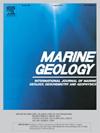Geochemistry of surface sediments from ultra-slow spreading eastern SWIR 63°E–69°E: Inferences on hydrothermal signatures
IF 2.2
3区 地球科学
Q2 GEOSCIENCES, MULTIDISCIPLINARY
引用次数: 0
Abstract
The seawater precipitation, hydrothermal input (plume-derived or weathered sulfide), and weathering of nearby rock outcrops constrain the dominant end-member components in the mid-ocean ridge (MOR) sediments. We have conducted mineralogical, geochemical, and statistical studies of surface sediments from the eastern part of the ultra-slow spreading Southwest Indian Ridge (SWIR) 63°E–69°E. Further, we combined factor analysis and linear regression to demonstrate how relative enrichment/depletion of certain elements compared to the general regional sediment composition can constrain the local seafloor processes. Mineralogy and factor analysis of the carbonate-free geochemical data reveal that the sediments consist of three main end-members with respect to Al, Ti, Mg, Fe, Mn, K, Rb, Cu, Zn, V, Cr, Ni, and As; the end-members are mixed in different proportions in the sediments. The three endmember components, authigenic hydrothermal minerals – Fe-Mn-(oxyhydr)oxides, bernessite, and hematite; basaltic detritus – Labradorite and alteration products (montmorillonite, vermiculite, and illite); and ultramafic detritus – antigorite, account for 62.3 %, 21.8 %, and 10.2 % of the elemental variance, respectively. We also used Ti/Al vs Cr/Al and Ni/Al proxies to show that some samples consist of ultramafic and serpentinized detritus. The sediment sample C-GC-16(0-1 cm) at 67.260° E, 26.574° S, consists of relatively high conservative and redox-sensitive elements (U, Mo, V, As), alkali metals (K, Rb, Cs), and Cu, reflecting the presence of a hydrothermal source in the near vicinity. Moreover, linear relations reveal the relative scavenging of REEs from the seawater by Fe-Mn-(oxyhydr)oxides, which are recorded by Ce anomaly and REE fractionation values relative to Fe and Mn content.
超慢扩张SWIR东部63°E - 69°E表层沉积物地球化学:热液特征的推断
海水降水、热液输入(岩柱衍生或风化硫化物)以及附近岩石露头的风化作用限制了洋中脊(MOR)沉积物的主要端元成分。我们对西南印度海岭(SWIR)东部63°E - 69°E超缓慢扩张的表层沉积物进行了矿物学、地球化学和统计学研究。此外,我们将因子分析和线性回归相结合,以证明与一般区域沉积物组成相比,某些元素的相对富集/耗尽如何约束局部海底过程。无碳酸盐地球化学数据的矿物学和因子分析表明,沉积物由Al、Ti、Mg、Fe、Mn、K、Rb、Cu、Zn、V、Cr、Ni和As 3个主要端元组成;端元在沉积物中以不同比例混合。三种端元组分为自生热液矿物铁锰氧氧化物、伯恩黑石和赤铁矿;玄武质碎屑-拉布拉多石和蚀变产物(蒙脱石、蛭石和伊利石);超镁质碎屑—反长花岗岩分别占元素方差的62.3%、21.8%和10.2%。我们还使用Ti/Al对比Cr/Al和Ni/Al来表明一些样品由超镁质和蛇纹石化碎屑组成。沉积物样品C-GC-16(0 ~ 1 cm)位于67.260°E, 26.574°S,由较高的保守性和氧化还原敏感性元素(U、Mo、V、As)、碱金属(K、Rb、Cs)和Cu组成,反映了附近存在热液源。此外,Fe-Mn-(氧合)氧化物对海水中稀土元素的相对清除作用与Ce异常和稀土元素相对于Fe和Mn含量的分馏值呈线性关系。
本文章由计算机程序翻译,如有差异,请以英文原文为准。
求助全文
约1分钟内获得全文
求助全文
来源期刊

Marine Geology
地学-地球科学综合
CiteScore
6.10
自引率
6.90%
发文量
175
审稿时长
21.9 weeks
期刊介绍:
Marine Geology is the premier international journal on marine geological processes in the broadest sense. We seek papers that are comprehensive, interdisciplinary and synthetic that will be lasting contributions to the field. Although most papers are based on regional studies, they must demonstrate new findings of international significance. We accept papers on subjects as diverse as seafloor hydrothermal systems, beach dynamics, early diagenesis, microbiological studies in sediments, palaeoclimate studies and geophysical studies of the seabed. We encourage papers that address emerging new fields, for example the influence of anthropogenic processes on coastal/marine geology and coastal/marine geoarchaeology. We insist that the papers are concerned with the marine realm and that they deal with geology: with rocks, sediments, and physical and chemical processes affecting them. Papers should address scientific hypotheses: highly descriptive data compilations or papers that deal only with marine management and risk assessment should be submitted to other journals. Papers on laboratory or modelling studies must demonstrate direct relevance to marine processes or deposits. The primary criteria for acceptance of papers is that the science is of high quality, novel, significant, and of broad international interest.
 求助内容:
求助内容: 应助结果提醒方式:
应助结果提醒方式:


